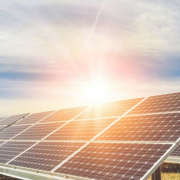What is energy transition?

We have a plan!
We created the Faculty of Energy Transitionand we have obtained official Carbon Footprint Calculation Certification as part of our commitment to sustainability.
Digitalisation, renewable energy sources and energy carriers, and the transition to natural gas are the cornerstones of energy transition.
Climate change is real. According to the European Space Agency (ESA), the average global temperature in 2021 was 0.27°C higher than the average over the period from 1991 to 2020, and 0.64°C higher than the average over the period from 1981 to 2010. The potential impact of climate disruption is huge and will have serious consequences, from melting glaciers to drinking water shortages and an increase in the frequency of extreme weather events, which will affect us all.
The scientific consensus today is that the cause of this climate disruption is the increase of greenhouse gas (GHG) emissions into the atmosphere as a result of human activity. 90% of the most common polluting gas, CO2, is emitted by the energy industry, mostly from coal-fired power plants.
The Paris Agreement, a legally binding international treaty, was adopted in December 2015 in an attempt to remedy this situation. It created a global framework for combating climate change which came into force in November 2016. Its ultimate goal, which governments recommitted to at COP26 in Glasgow at the end of 2021, is to limit the average global temperature increase by the end of the century to no more than 1.5ºC above pre-industrial levels. In order to achieve this target, it is considered crucial that GHG emissions be reduced by 55% by 2050.
What is energy transition?
The most powerful tool at our disposal in our efforts to achieve this target is energy transition. This increasingly common term refers to the urgently required comprehensive overhaul of our current energy system, powered by the burning of fossil fuels and intensive energy production in large, grid-connected facilities, and the creation of a new model centred on the use of renewable energy sources, electrification and distributed generation.
Although energy transition is a slow process which demands extensive changes to both energy production and distribution processes and consumption patterns, this process is already underway in many places and socially conscious companies are increasingly choosing to make changes and take action, moving on from theory to practice. We are part of this group.
We are one hundred percent committed to this structural change and our commitment is not merely theoretical; we put it into practice by doing our utmost to ensure that the measures necessary to carry out this transition which are within our reach are implemented as quickly and effectively as possible.
The way forward for energy transition
The five cornerstones of energy transition:
1- Renewable energy sources and energy carriers
In order to meet demand as coal-fired power plants are closed, the proportion of our energy which comes from renewable sources needs to increase; production capacity is far greater than what we currently generate. But many of these sources are unreliable, meaning that we can’t control the energy generated as we would like to. In order to ensure the security of the grid, these sources must be complemented by some kind of technology which allows energy to be stored for gradual release as needed. These technologies are called energy carriers, and hydrogen is increasingly important to those which currently exist.
2- Natural gas
The road to all of our energy demands being met by renewable sources will be slow and painstaking, and alternative means of generating energy are needed as we carry out the process. This is why natural gas plays an important role in our energy transition strategies. Although it is a fossil fuel, natural gas emits 40-50% less CO2 than coal and 25-30% less than fuel oil, meaning replacing these with gas results in a considerable reduction in GHG emissions.
3- Mobility
In Spain, transport is not only the sector with the highest energy consumption, it is also the least diversified in terms of energy sources, depending almost exclusively on petroleum products. Moreover, it is one of the largest sources of pollution from combustion gases in cities, greatly affecting air quality. A sustainable mobility strategy is therefore essential to the energy transition.
One obvious solution is to increase the use of electric vehicles. Among the advantages of this form of transport are the lack of direct CO2 emissions and the reduced impact on people’s health, since electric vehicles do not emit exhaust fumes.
4- Digitalisation and energy efficiency
The digitalisation of energy at each and every stage of the process, from production through to transport, distribution and final consumption, will improve traditional business models by enhancing the value of the enormous amount of information available to companies and helping them anticipate new trends.
For example, big data analytics, artificial intelligence and the Internet of Things, all of which rely on data and autonomous learning algorithms, allow us to monitor and manage power generation at numerous production sites, thereby making it possible to identify anomalies in real time and reduce repair times.
5- The circular economy
Our current economic system is based on the linear ‘take-make-waste’ model in which products have a finite life cycle after which they must be replaced. This generates an enormous amount of trash. In contrast, the circular economy is based on the maxim of ‘reduce, reuse, recycle’ and is aimed at achieving long-term sustainability by reducing the volume of trash and keeping goods in the production cycle for as long as possible. Simply put, this approach seeks to achieve more with less.
A shift in our economic system towards a circular economy would not only reduce the environmental impact of waste by reusing it as new raw material but would also lead to improved efficiency in production processes and a reduction of associated emissions.

The Genesal Energy plan
We have developed our own Energy Transition Plan as part of our commitment to sustainability, the 2030 Agenda and clean energy. So, what does this plan consist of? It is a set of short, medium and long-term measures aimed at changing the way we do things at the corporate, production and industry levels.
We want to contribute to improving society; the implementation of more sustainable and efficient solutions in our product manufacturing processes is one of the cornerstones of this strategy, but it is not the only one.
As prominent champions of the energy transition, we lead by example. As part of our business strategy, we have engaged in a process of identifying and prioritising 11 of the 17 United Nations Sustainable Development Goals (SDGs). This is one of our contributions to advancing the 2030 Agenda, but not the only one.
Our search for more efficient energy solutions includes concrete actions such as accelerating the transition from diesel to gas, improving energy efficiency, promoting hybridisation with renewable energy sources and energy storage, and committing to innovation and the digitalisation of energy.
More research
Research and education are essential components of our Energy Transition Plan, which is why we have created, in collaboration with the University of Santiago de Compostela, the USC-Genesal Energy Faculty of Energy Transition. The specialised faculty is the first of its kind in Galicia.
The goal of the faculty is to promote research and support education and the diffusion of knowledge in the field of energy transition, particularly those areas focused on distributed energy systems. Its remit includes developing self-sustaining distributed energy grid technologies and systems based on zero carbon fuels, analysis of energy transition processes and the eco-design of distributed energy generation systems.
Action at the industry level and the corporate level
Our plan outlines actions to be taken at both the industry and corporate levels.
As part of the distributed energy industry, the company is constantly on the lookout for opportunities to participate in associations which encourage leading Spanish and international companies specialising in generator sets to share their experience and knowledge; as part of this policy, we have become members of EuropGen, Cluergal and Viratec, the Galician Cluster of Environmental Solutions and Circular Economy.
At the corporate level, we have obtained Carbon Footprint Calculation certification, reflecting our commitment to SDG 13 (on climate action).

Goals and results
Our Energy Transition Plan aspires to more than instigating change at the industry and corporate levels, however: we want to contribute to changing the world, starting with ensuring we are a socially conscious company.
Our most recent efforts in this regard include the installation of a photovoltaic roof at our headquarters in Bergondo, A Coruña, and reducing the fuel consumption of our vehicle fleet by 16%.
The quantity of fossil fuels consumed by our vehicle fleet decreased from 2377.75 litres per million euros invoiced in 2019 to 2005.4 l/M€ in 2021; this represents a 16% drop in fuel consumption, reflecting our understanding that the cleanest energy is that which is not consumed.
Building an emissions-neutral future is a team effort; we are all protagonists of change. At Genesal Energy we are committed to the planet and the environment, and to implementing the strategy laid out in our Energy Transition Plan in line with United Nations SDG 13.
To summarise, the Genesal Energy Energy Transition Plan is based around three core objectives, each of which involve taking concrete action:
Complete the transition to a sustainable energy model.
A1. Reduce energy consumption at company facilities and increase the use of renewables by installing a photovoltaic self-consumption system.
A2. educe dependence on oil by speeding the transition from diesel to gas and implementing a sustainable mobility strategy.
A3. Increase energy efficiency in all areas of the company through digitalisation.
Reduce our carbon footprint
This involves making steady progress on the path to emissions neutrality; key to this objective is keeping a record of the emissions generated in the course of our commercial activities.
At Genesal Energy, we have already taken important steps along this path: we have been calculating the Scope 1 and 2 emissions which contribute to our carbon footprint since 2019, and our CF calculation will improve when we add Scope 3. In the meantime we will continue to work on strategies to reduce and offset our emissions.
Mainstream climate action
A5. Contribute to mitigating the impact of economic growth on the environment by optimising the use and reuse of outflows and waste.
A6. Fight energy poverty. At Genesal Energy we are committed to all aspects of the energy transition, including our social responsibility. As part of this responsibility, we are working on a plan to provide energy to vulnerable families free of charge.











